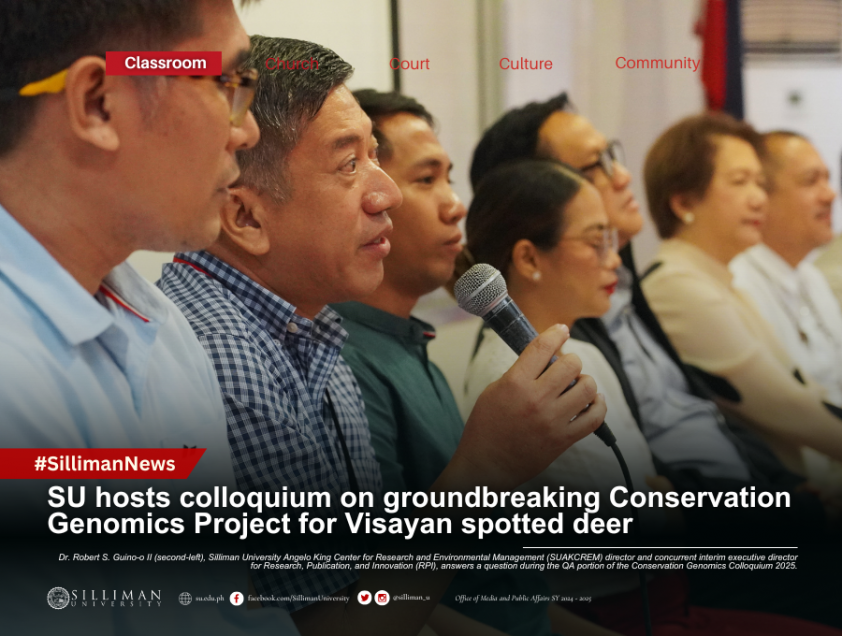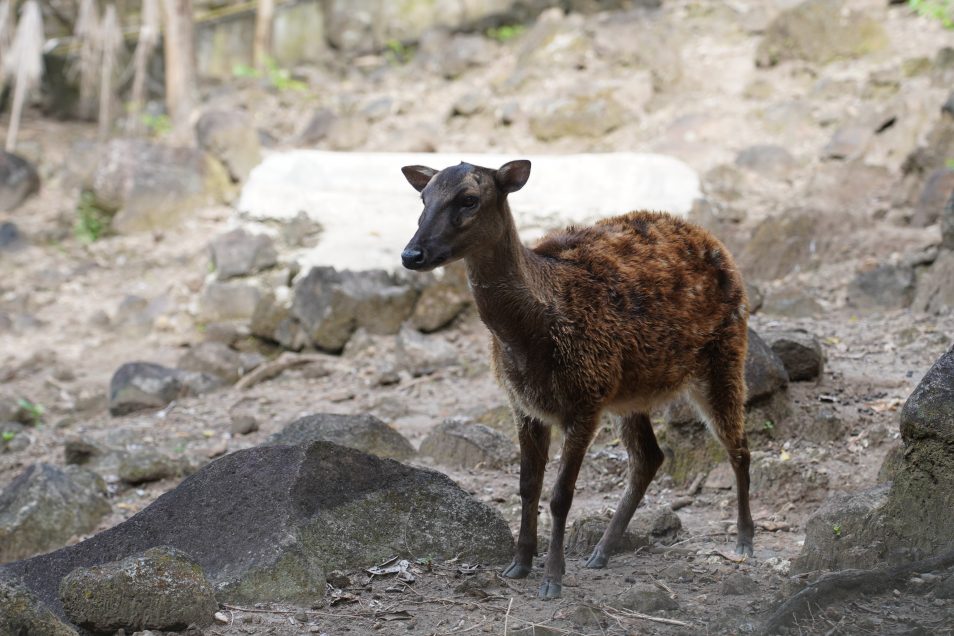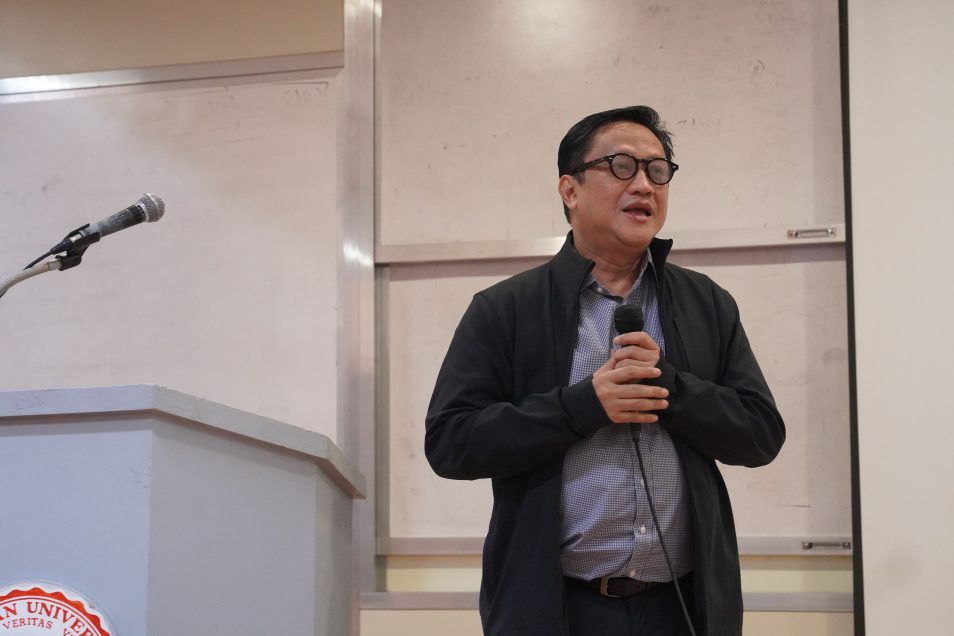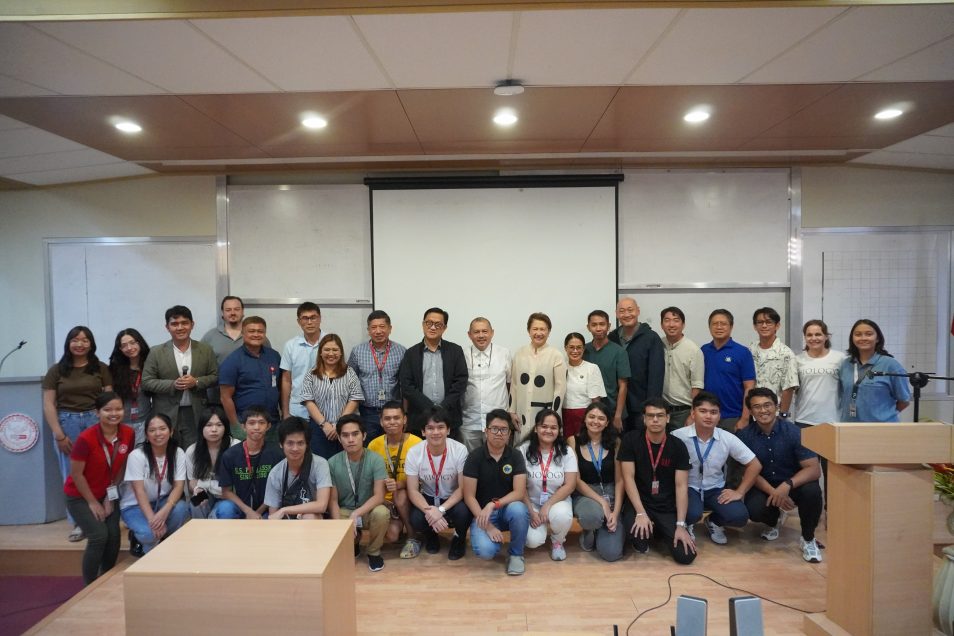
SU hosts colloquium on groundbreaking Conservation Genomics Project for Visayan spotted deer

(L-R) Asst. Prof. Persie Mark Q. Sienes, Silliman University (SU) Biology Department PSD Genetics faculty researcher; Dr. Robert S. Guino-o II, SU RPI Director; Albert Noblezada, PGC Bioinformatics specialist; Carmel Javier, PGC Bioinformatics specialist, Atty. Angelo A. Jimenez, University of the Philippines (UP) president; Dr. Cynthia P. Saloma, Philippine Genome Center (PGC) Biodiversity Program director; and Dr. Clement C. Camposano, UP Visayas (UPV) chancellor, answer questions during the QA portion of the Conservation Genomics Colloquium 2025.
Silliman University, through the Angelo King Center for Research and Environmental Management (SUAKCREM) and SU Biology Department, hosted a press conference on April 15, 2025, to present the draft whole genome sequence of the Visayan Spotted Deer (VSD) (Rusa alfredi), a key input of its captive breeding program and conservation genomics efforts, in collaboration with the University of the Philippines and the Philippine Genome Center, at the MBA Presentation Room, College of Business Administration Building, Silliman University.
“Genomics in Conservation: Mapping the Future of Biodiversity” gathered scientists and experts from SU, University of the Philippines Visayas, Philippine Genome Center (PGC), Department of Science and Technology (DOST), and Talarak Foundation, Inc., along with 1,048 registered on-site and online participants, for a colloquium centering around conservation practices, the status of endangered endemic species currently in captive breeding sites, institutional initiatives, and case studies focused on the VSD.

A curious female Visayan spotted deer watches from her pen at SU’s Center for Tropical Conservation Studies (SU-CENTROP) in Palinpinon, Valencia, Negros Oriental.
The successful sequencing of the VSD genome represents a major milestone in Philippine conservation science. Accomplished in under a year by an all-Filipino research team from SU and UP, the project was made possible through advanced sequencing technology from the PGC.
This milestone enables the development of species-specific genetic markers for science-based captive breeding and reintroduction programs of the critically endangered Visayan spotted deer.

Addressing both on-site and online participants, Dr. Betty Cernol McCann, SU president, explains that the shift toward genomics opens exciting possibilities for conservation biology.
In her welcome address, Dr. Betty Cernol McCann, SU president, emphasized Silliman’s long-standing tradition of biological discovery and conservation, framing the university’s latest efforts within its century-old commitment to environmental stewardship.
“This conservation genomics press conference represents a step forward in our continuing commitment to safeguard Philippine biodiversity,” McCann said, underscoring the event’s significance.
“Using molecular genetic tools and institutional collaboration between Silliman University, the University of the Philippines, and the Philippine Genomics Center, we now deepen our understanding of the Visayan Spotted Deer’s evolutionary uniqueness and strengthen strategies to secure its survival for future generations,” she added.
University of the Philippines Visayas Chancellor Dr. Clement C. Camposano delivered a short address highlighting UP’s mission to support and build capacity in higher education research and extension.

Dr. Clement C. Camposano, University of the Philippines Visayas (UPV) chancellor, emphasizes the importance of partnerships among higher education institutions.
“We’re not just happy—we’re actually elated that UP Visayas was able to partner with Silliman University for this important scientific milestone because it shows what partnerships can actually do,” Dr. Camposano shared.
“… This [colloquium] represents the continuity of our commitment to engage this issue [the need to preserve the endemics of Panay and Negros]… we need to link our institutions through symbolic activities, and I think this conversation, this colloquium, is a very good way to demonstrate that bond, that fusion that we’re talking about…” the UPV chancellor further explained.
How genomics informs conservation strategies

Dr. Cynthia P. Saloma, PGC Biodiversity Program director, delivers her keynote address
Dr. Cynthia P. Saloma, PGC Biodiversity Program director, delivered the plenary talk “Conservation Genomics Program,” which explained the vital role of genomics in biodiversity conservation strategies.
Conservation genomics is an interdisciplinary field that applies genomic tools to the study and preservation of biodiversity. By examining entire genomes, it reveals patterns of genetic variation and provides insight into the population dynamics of threatened species. Its primary goal is to assess genetic diversity both within and across populations.
Saloma lists down the ways genomics provides insights and strategies on how to protect endangered species, particularly in areas such as (a) genetic diversity assessment, (b) species identification and delimitation, (c) inbreeding bottlenecks detection, (d) conservation breeding programs, (e) evolutionary potential and adaptation, (f) phylogenetic prioritization, (g) reintroduction and restoration, (h) combating wildlife trafficking, (i) climate change resilience, (j) disease resistance, (k) environmental DNA monitoring, and (l) policy and implementation.

SU and UP scientists responsible for the draft whole genome project of the Visayan spotted deer pose after the event (L-R: Asst. Prof. Persie Mark Q. Sienes, SU faculty researcher; Dr. Robert S. Guino-o II, SUAKCREM director and executive director for Research, Publication, and Innovation (RPI); Atty. Angelo A. Jimenez, UP president; Carmel Javier, PGC Bioinformatics specialist; Albert Noblezada, PGC Bioinformatics specialist, Dr. Clement Camposano, UP Visayas Chancellor; Dr. Victor Marco Emmanuel Ferriols, AED PGC; and Dr. Carmelo del Castillo, UP Visayas Aquaculture specialist).
In the local context, conservation genomics, according to Saloma, supports communities in creating targeted conservation strategies, tracking species health and population trends, and guiding management decisions and resource allocation. It also aids collaboration with government agencies such as the Department of Environment and Natural Resources (DENR), Bureau of Fisheries and Aquatic Resources (BFAR), and the Department of Science and Technology (DOST).
Saloma also commended SU for its decades-long efforts in conservation.
“You have a very, very good reputation for conservation efforts and also for marine conservation of coral species and I hope with the partnership of the Philippine Genome Center and talent in bioinformatics of our young people we can bring to the table the various expertise from field biology to genomics to bioinformatics that would have a lot of impact in our conservation efforts as well as in the restoration of all these species,” she said.
The presentation of project highlights followed, featuring the SU-DOST research on DNA barcoding and haplotype analysis of the Visayan spotted deer and SU’s conservation programs led by Guino-o II.
Moving forward

Atty. Angelo A. Jimenez, UP president, urges the scientific community to make science aspirational for the youth.
University of the Philippines President Atty. Angelo A. Jimenez capped the event by championing the importance of making science aspirational and accessible to the public, especially the youth, in this fast-paced digital age.
“The young Filipinos today are searching for meaning… We want to particularly stress on science and technology. Right now, we want to be able to show that the spotted deer matters,” Jimenez said in his closing remarks.
“I am here to promote what you’re doing. But beyond that, to be able for you to serve as examples of what science can do not just to protect the environment but to drive progress with equity as well,” he explained.
The UP president also challenged the scientific community to be better communicators.
“The science communicator today is very important for promoting public support. Number two, try to produce great examples of what can be done. Number three, go to your communities,” Jimenez said.
“Go out there. Talk to the people. And through science, suggest solutions to real-world problems,” he added.

On-site student participants from SU pose with the guests after the event
In the afternoon, Guino-o II led the guests for a tour around SU’s CENTROP in Palinpinon, Valencia, to see the Visayan spotted deer, the Visayan warty pig, and the Negros bleeding heart pigeon.
Present at the colloquium were Atty. Gilbert Arbon, DOST Negros Oriental provincial director; Dr. Victor Marco Emmanuel Ferriols, AED PGC Visayas program director and assistant to the PGC executive director; Albert Noblezada, PGC Bioinformatics specialist; Dr. Aye Mee F. Bartocillo, DOST Balik Scientist based in SU/SU Biology Department faculty; Dr. Sanny David Lumayno, UP Visayas fish scientist; Dr. Carmelo del Castillo, UP Visayas Aquaculture specialist; Carmel Javier, PGC Bioinformatics specialist; Matt Ward, Talarak Foundation, Inc. executive director; Asst. Prof. Leandro S. Cabrera, CENTROP coordinator; Asst. Prof. Michael Lawton R. Alcala, SU Biology Department chair; Rev. Jonathan R. Pia, SU Church senior pastor; John Edgar C. Rubio, SU English Department faculty member and the event host; and the Biology Department and SUAKCREM faculty, staff, and students.
The following scientists comprised the Visayan spotted deer genome team: Ma. Carmel F. Javier, Albert C. Noblezada, Persie Mark Q. Sienes, Robert S. Guino-o, Nadia Palomar-Abesamis, Maria Celia D. Malay, Carmelo S. del Castillo, and Victor Marco Emmanuel N. Ferriols (see journal article at https://gigabytejournal.com/articles/150).



